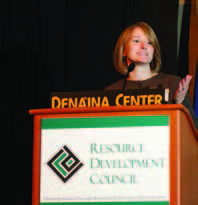Mining: key to Alaska’s economic diversity
By Marleanna Hall
The Council of Alaska Producers has been around for the last 22 years, representing large metal mines and advanced projects in Alaska, said Karen Matthias, RDC board member, and Managing Consultant, Council of Alaska Producers.
“We work very closely with the Alaska Miners Association, and I want to recognize that they, this year, are celebrating their 75th anniversary – 75 years of promoting responsible, sustainable mineral development in Alaska,” noted Matthias.
Another milestone is the Red Dog Mine in Northwest Alaska, and Greens Creek, near Juneau, both of which started operations 25 years ago. Large scale metal mining in Alaska is a young industry. All five of the large metal mines in Alaska were permitted since the passage of the National Environmental Policy Act and the Clean Water Act (CWA).
“You don’t hear a lot about them, and that’s because they have excellent track records,” said Matthias. “We want to do a better job talking about these success stories.”
“Another success story is the Usibelli Coal Mine near Healy,” said Matthias. “It has been in continuous operation since 1943.”
The coal mine provides fuel for 30 percent of Interior Alaska’s electricity needs. Long before reclamation was law, the Usibelli’s began reclaiming areas mined for coal.
Mining provides more than 5,000 mostly year round jobs in Alaska, paying an average salary of $100,000 per year, more than twice the state average.
In 2013, mining contributed $157 million to local and state government, while Native corporations received $144 million.
“In the 25 years that Red Dog has been operating, NANA has received almost $1 billion in royalties,” noted Matthias. “And through ANCSA revenue sharing, 70 percent of that almost $1 billion has gone to all of the regional and village corporations.”
“Mines are the largest property tax payers in the Northwest Arctic Borough, Fairbanks-Northstar Borough, and the City and Borough of Juneau,” added Matthias.
Potential projects include Donlin Gold, currently in permitting, as well as Livengood, Chuitna, and Pebble. These projects could provide up to 3,200 jobs during operations, not including jobs during construction.
One challenge facing the mining industry is lack of investment. In 2011, $365 million was spent on exploration in Alaska. 2013 was down to $176 million and it is expected to be only $80 million in 2014.
“Alaska has great potential,” said Matthias.
The annual Fraser Institute Survey has Alaska at the top for mineral potential. However, when the Institute weighs it 60 percent mineral potential and 40 percent policy perception, Alaska becomes number five. And when only policy perception is looked at, Alaska slides to number 21.
“A lot of that policy perception has to do with permitting delays,” explained Matthias.
Permitting delays are being seen by projects like Greens Creek’s 18-acre expansion of an existing dry-stack tailings facility that has taken over four years and permitting is still not complete. Another example is the Wishbone Hill project near Palmer, the mine permit has been renewed but was challenged by environmental groups.
Pebble continues to face pre-emptive veto, the first of its kind in the 42 year history of the CWA.
“Any project in any industry should have the opportunity to have transparent rules that are consistently applied,” said Matthias.
Challenges facing the industry also include expanded definition of Waters of the U.S., escalating wetlands mitigation costs, and power plant emissions regulations.
“Please, talk to your kids, your neighbors, random strangers – tell them how much they depend on minerals in their lives,” urged Matthias. “We need mining, and it must be done right, and it can be done right,” Matthias added.

Karen Matthias
Return to newsletter headlines